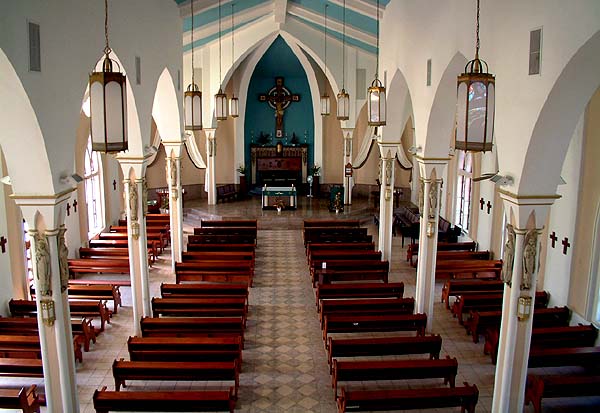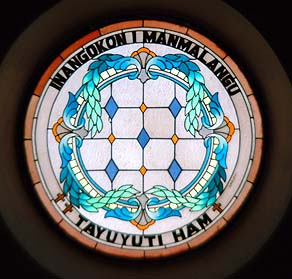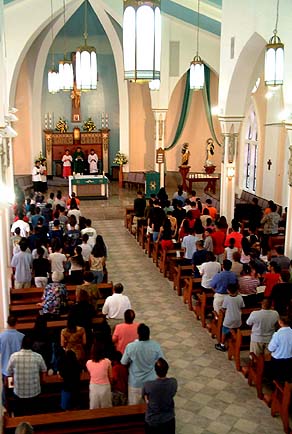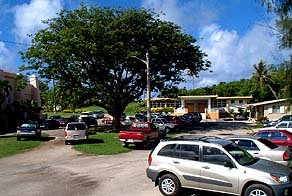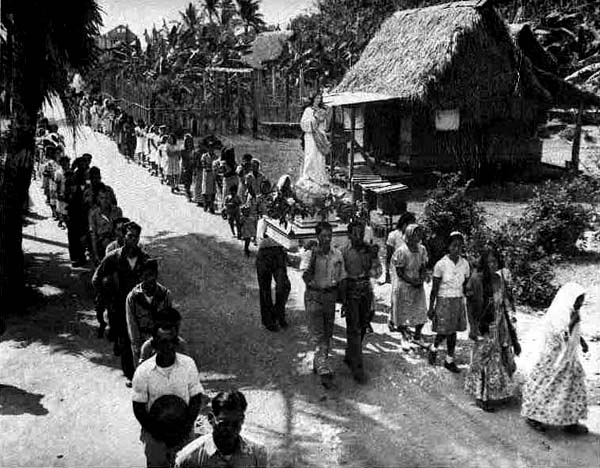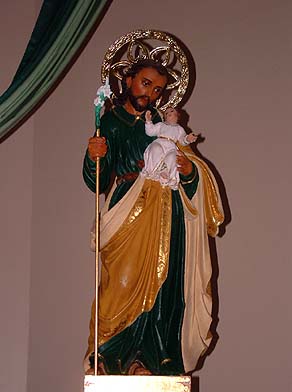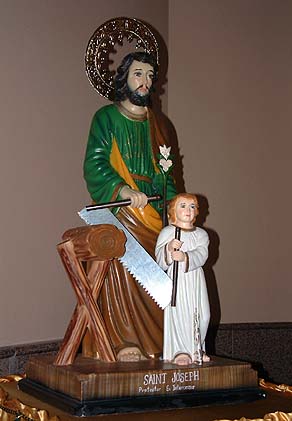 |
 |
 |
 |
||||
|
|
|
|
|
|
|
|
|
|
|
|||||||
|
|
|
|
The nave of St. Joseph's Church.
|
|
|
"We have two masses," Judy
tells us, "and we have enough people to support two masses. So
that’s an important part of the community here: the parish is just
as important as the municipal council, maybe more. "I know when I moved away from Inarajan, it was very hard to break that tie. I lived in Sinajana for five years, and most of those five years I came down here for church, because I didn’t want to be seen as abandoning Inarajan, leaving Inarajan. We don’t want to abandon our home. I know one of our board members, she doesn’t really even have family here anymore, they’re dispersed all over the island, but she still comes here for church, she’s a member of the choir."
|
||
|
|
||
|
"My brother wanted to create a choir for the 6:30 a.m. mass," Bill relates. "I became the organist for that 6:30 a.m. mass and I said, 'You know, one thing I see as a very big problem for me is the virtual absence of Chamorro music for appropriate liturgy.' That was really no big task, so I started writing, and it took me a while to be able to do that. “The Chamorro language, you still see it spoken. I speak it very fluently and I’ve written things in the language. To date, I’ve composed at least 150 songs for the different parts of the liturgy, the mass, all in Chamorro, and I’ve written them with musical scores. We now actually have that 6:30 a.m. mass in Chamorro. The only thing that is not done in Chamorro is the two readings."
|
|
|
|
|
|
|
“We have two fiestas in Inarajan," Therese explains. "The feast day for St. Joseph the Husband is on March 19. They have one mass, and a very small fiesta in the evening. But that’s only for one day. A lot of people from all over the island come. The church is filled, standing room only, and it came to a point where we had canopies outside the church to accommodate the people that couldn’t fit inside. "In the first weekend of May, it’s the feast day of St. Joseph the Worker. It’s our main fiesta in Inarajan, and lasts for one or two weekends. A fiesta is not exactly an ‘all-stop-work' holiday for the village of Inarajan. It’s usually on the weekends." "When I was growing up," Judy recalls, "every single house had a fiesta on that day. What I see happening now is relatives, children, cousins from all over will come to a particular house, and they all bring their food and it’s like a family gathering. The next block over, there are only a few houses that are still occupied. There are a lot more houses that are abandoned or empty, but the remaining people make a block party. All those people get together and have a block party for a fiesta."
|
|
"St. Joseph is honored for two particular reasons. It’s the same person, but his roles are different. St. Joseph was the husband of Mary. He was the one taking care of Jesus and supported Mary and taking care of them. So his role was to support the family, to take care of Jesus and Mary as a husband and as a father. "St. Joseph the Worker, people have him as their patron saint because he symbolizes labor, and the importance of working, and why work is so essential to everyday life."
|
|
|
|
|
|
A procession carrying a statue of Santa
Maria Kamalin in Inarajan, 1945.
|
|
The procession that carries the statue of St. Joseph through the streets of Inarajan is a tradition with very old roots in Chamorro culture. Therese remarks that Chamorro culture is found in "the way we celebrate Lent, the way we celebrate Christmas." She explains: "In Lent, for example, during Holy Week, on Holy Thursday — Holy Thursday is the day the we re-enact the last supper and the washing of the feet where Jesus washes his Apostles’ feet before he continues with the last supper. On Friday, we have a procession, after Jesus has been crucified and his body is taken down, and so, we have a procession around the village. According to my grandfather, that’s been going on for many, many, many generations. We have a certain family that takes care of the casket, where Jesus lies, and it’s carried around the village."
|
||
|
|
||
|
“We’ve had three re-enactments of the arrival of the statue of St. Joseph in 1680 which established the church," Judy explains. "One was just this past fiesta. Bill Paulino researched the history." Therese recalls, “I think that included the Coast Guard. They brought the statue in, and then some men went out on a boat and took the statue down and brought the statue on shore. We had the Archbishop and other clergy meet the statue here, and they had a procession around the village over to the church." "The statue in the church now, it’s been through face lifts so it’s kind of different from the original one," Therese adds.
The original statue, representing St. Joseph the husband, at St. Joseph's church in Inarajan.
|
|
|
|
"I’m curious to know how old that actual statue is that they’re using," Judy asks, "because there are oral histories with that statue saying that when it was sent to the Philippines to be repaired before the War, there was a typhoon. Weather was bad, and it wouldn’t stop raining, and all that kind of thing — nothing was right until the statue came back." "Father Manny Ombao felt we needed to explain to our children the difference between these two feast days," Therese says, "because we had only one statue, with two feast days. So when he went to the Philippines, he commissioned somebody to create a new one, and this is the only St. Joseph statue of its kind. "He brought it to Guam and presented it to the congregation. It wasn’t blessed or anything, but he wanted our input on whether we wanted to keep the statue or whether we wanted to stay with the original statue."
The new statue of St. Joseph the Worker.
|
|
|
|
|
"The introduction of Catholicism as it came in through the Spanish, it kind of enhanced what the Chamorro people already had," Therese says, "like the chenchule’. I know as the years go on, the teachings of the church change a little bit. But it’s only to conform to how people are feeling at present. We can’t go back to the Dark Ages where if you said something about the Catholic faith, you got tortured. That’s not right. "Natural causes, manmade causes, things that happen, there’s always hope. And so I think that’s the reason that the Chamorro people have such a close relationship with the Church. It’s the feeling of family. I think that’s the main reason Catholicism works so well on Guam. It’s just family, and coming together, and helping each other."
|
||
|
|
||
|
With these thoughts, we turn to depart Inarajan.
|
||
|
|
||
|
|
|
|
|
|

|
| Inarajan Home | Map Library | Site Map | Pacific Worlds Home |
|
|
|
|
|
|
|
|||
| Copyright 2003 Pacific Worlds & Associates • Usage Policy • Webmaster |
|||
